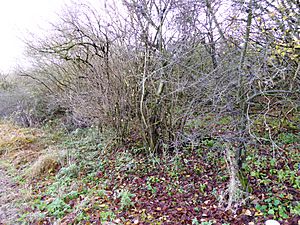Cleeve Hill SSSI, Berkshire facts for kids
| Site of Special Scientific Interest | |
 |
|
| Area of Search | Berkshire |
|---|---|
| Interest | Biological |
| Area | 4.0 hectares (9.9 acres) |
| Notification | 1983 |
| Location map | Magic Map |
Cleeve Hill is a special natural area in Berkshire, England. It is located south of a town called Lambourn. This area covers about 4 hectares (which is about 10 acres).
Cleeve Hill is known as a Site of Special Scientific Interest (SSSI). This means it's a place where plants, animals, or rocks are really important and need to be protected. The hill has grassy slopes made of chalk and some areas with mixed bushes. It's also part of the North Wessex Downs, which is a beautiful natural area called an Area of Outstanding Natural Beauty.
Contents
What Makes Cleeve Hill Special?
Cleeve Hill is a great place to learn about nature. It has a unique mix of plants and animals that thrive in its chalky soil. The area is protected to make sure these special species can continue to live and grow there.
Amazing Animals
Cleeve Hill is home to many interesting creatures, especially insects. These tiny animals play a big role in the ecosystem.
Butterflies
You might spot some beautiful butterflies fluttering around. Some of the special butterflies found here include:
- Dark green fritillary: This is a large, colorful butterfly with a striking pattern.
- Melanargia galathea (Marbled White): This butterfly has a unique black and white checkered pattern.
- Cupido minimus: As its name suggests, this is one of the smallest blue butterflies you can find.
Wonderful Wildflowers
The chalk grassland at Cleeve Hill is perfect for many types of wildflowers. These plants add color and life to the landscape. They also provide food and shelter for insects and other animals.
Grasses and Shrubs
- Zerna erecta (Upright Brome): A common grass found in chalky areas.
- Brachypodium sylvaticum (False Brome): Another type of grass that grows here.
- Crataegus monogyna (Hawthorn): A common shrub with white flowers and red berries.
- Cornus sanguinea (Dogwood): A shrub known for its red stems in winter.
- Viburnum lantana (Wayfaring Tree): A shrub with creamy white flowers and dark berries.
- Corylus avellana (Hazel): A shrub that produces tasty hazelnuts.
Colorful Flowers
- Campanula glomerata (Clustered Bellflower): A pretty purple flower that grows in clusters.
- Carlina vulgaris (Carline Thistle): A thistle with a unique, papery flower head.
- Dactylorhiza fuchsii (Common Spotted Orchid): A beautiful orchid with spotted leaves and pink flowers.
- Helianthemum chamaecistus (Common Rock-rose): A low-growing plant with bright yellow flowers.
- Linum catharticum (Purging Flax): A delicate plant with small white flowers.
- Lotus corniculatus (Bird's-foot Trefoil): A common wildflower with yellow, pea-like flowers.
- Pimpinella saxifraga (Burnet Saxifrage): A plant with tiny white flowers in flat clusters.
- Primula veris (Cowslip): A cheerful yellow flower that blooms in spring.
- Thymus drucei and Thymus pulegioides (Wild Thymes): These are fragrant plants that grow close to the ground.
- Scabiosa columbaria (Small Scabious): A pretty purple flower that attracts butterflies.
- Succisa pratensis (Devil's-bit Scabious): Another type of scabious with blue-purple flowers.
- Gentianella amarella and Gentianella germanica (Autumn Gentians): These are beautiful purple flowers that bloom later in the year.
- Platanthera chlorantha (Greater Butterfly-orchid): A tall orchid with greenish-white flowers.
- Listera ovata (Common Twayblade): An orchid with two large, oval leaves at its base.
Images for kids


